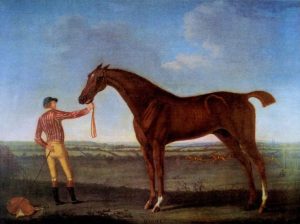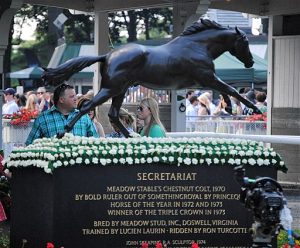
In American Thoroughbred racing, there is no achievement greater than the Triple Crown. To win the Triple Crown, a horse must win first place at three events in one year: the Kentucky Derby, opens a new window, Preakness Stakes, opens a new window, and Belmont Stakes, opens a new window. Of the dozens of winners of each event, only 13 horses have won the Triple Crown, and the most famed of these is Secretariat, the legendary champion of 1973. Secretariat’s records on some tracks still stand 50 years later! Join us as we celebrate Secretariat’s landmark achievements in speed, and be sure to check out CRRL’s collection for all the horse racing info you need. This is the story of how American horse racing came to be and how a Virginia horse ran like lightning!
First Out of the Gate: Thoroughbreds Before Secretariat
Horse racing had a presence in the colonies even before the founding of the United States. In Virginia, horse racing was first recorded in 1674, when what would evolve into Quarter Horses (good for running a quarter of a mile) were raced in Henrico County. These races happened before the Thoroughbred horses, descended from three 17th-century foundation sires--the Darley Arabian, the Godolphin Arabian and the Byerly Turk-- were first imported into the United States; that would happen in 1730, when British stud Bulle Rock, opens a new window was imported to Hanover County. Diomed, opens a new window, Medley, opens a new window, Shark,, opens a new window and Messenger were four significant sires that established the Thoroughbred breed in the U.S., paving the way for organized Thoroughbred racing. Regional rivalries of the Antebellum period led to huge crowds at tracks, where Thoroughbreds raced in at least two and possibly as many as five four-mile heats which tested the horses in a very different way from their modern counterparts.
The publication of the American Stud Book, opens a new window in 1868 was a key step in the development of the American Thoroughbred; this book allowed breeders to report their horses and their horses' origins, making it easier to keep track of Thoroughbreds. What would come to be known as the three Triple Crown races began soon after: the Belmont Stakes (New York) in 1867, the Preakness Stakes (Maryland) in 1873, and the Kentucky Derby in 1875. Horse racing’s popularity extended far beyond the owners and breeders in the landed upper class, as betting on the races was always popular. Even bans on betting starting in 1909 didn’t stop the sport’s growth; parimutuel betting, opens a new window became the preferred means of getting around bans on racetrack betting. The onset of the Great Depression, opens a new window was an impetus for many states to re-legalize betting to increase their revenues, and horse racing was popular throughout the 1930s. The term "Triple Crown" was coined by Charles Hatton, a columnist for the Daily Racing Form to refer to these races in the 1930s, and other newspapers started to pick up the phrase during the 1940s. However, it was not an official award of the Thoroughbred Racing Association until 1950.
The rise in popularity of Thoroughbred racing during the 30s and 40s likely had to do with the large number of Triple Crown winners during this period. The only winner before the Depression was Sir Barton, opens a new window in 1919. The 1930s saw Gallant Fox, opens a new window (1930), Omaha, opens a new window (1935) and War Admiral, opens a new window (1937) achieve the Triple Crown. In the 1940s, Whirlaway, opens a new window (1941), Count Fleet, opens a new window (1943), Assault, opens a new window (1946), and Citation, opens a new window (1948) all became Triple Crown winners. It would be 25 years before another horse would be declared a Triple Crown champion.
Secretariat, Champion of Champions
On the early morning of March 30, 1970, Secretariat was born in Caroline County, Virginia,, opens a new window at Meadow Farm, now known as Meadow Event Park., opens a new window Secretariat stood out from a young age; Howard Gentry, opens a new window, Meadow Farm’s manager, claimed that Secretariat was “as perfect a foal that I ever delivered.” Nicknamed “Big Red, opens a new window”, the young Secretariat was noted early on for his massive size, large chest and heart, and powerful hindquarters. He had the blood of champions in him; his sire, Bold Ruler, opens a new window, had won numerous races in his three-year season, including the 1957 Preakness Stakes. His dam, Somethingroyal, was one of many horses sired by noted stud Princequillo, opens a new window. Secretariat would go on to surpass all his ancestors on the track.
Secretariat began his series of commanding victories in his two-year-old season. His first win was on July 15, 1972 at Aqueduct Racetrack, opens a new window; he won by an impressive six lengths. He was ridden for the first time by the man who would become his main jockey, Ron Turcotte, on July 31, and won once again. Together, Turcotte and Secretariat would go on to win the Hopeful Stakes, opens a new window by five lengths and the Belmont Futurity Stakes, opens a new window by a length and a half. Although Secretariat failed to win the Champagne Stakes, opens a new window because he bumped his rival, Stop the Music, opens a new window, he delivered powerful wins in the Laurel Futurity, opens a new window (by eight lengths) and Garden State Stakes, opens a new window by (three and a half lengths) afterwards. These five races are considered the mark of future success for all two-year old horses, and Secretariat won four out of five of them. Noted for his tendency to start in last place yet gain incredible speed during the races and finish far ahead of his opponents, Secretariat managed to become the very rare two-year-old horse to win the American Horse of the Year, opens a new window award. Only one horse since Secretariat, 1997’s Favorite Trick, has won during his two-year-old season.
As impressive as his early achievements were, it was for his three-year-old season that we remember Secretariat. American horse racing derived the concept, opens a new window of restricting the some of the most prestigious races to three-year-olds, somewhat akin to British racing, and has never opened them to other ages; Secretariat would have only one shot at Triple Crown glory. Prior to the Kentucky Derby, there was controversy over Secretariat’s chances for victory. He won the Bay Shore Stakes, opens a new window by over four lengths and matched the track record for the Gotham Stakes, opens a new window, but only finished third in the Wood Memorial, opens a new window, a race he was favored to win. Jockey Ron Turcotte claimed his loss, opens a new window was due to a mouth abscess, but some theorized, opens a new window that Secretariat had a weak knee and was secretly treated with ice packs. Secretariat proved them wrong by thundering down the homestretch of Kentucky Derby, winning with a record time of 1:59 ⅖, opens a new window, which still stands to this day! His winning time is even more remarkable considering that he ran each of the five quarter-mile segments of the Derby faster than the one before, as opposed to starting rapidly and gradually slowing like a more typical Thoroughbred.
His victories in the two remaining Triple Crown races were no less impressive. In the Preakness Stakes, Secretariat made another impressive last-to-first run that was overshadowed by controversy over whether he had broken the 1:54 track record set by Canonero II, opens a new window in 1971. When Secretariat finished, the clock read 1:54 ⅖, but the timer had malfunctioned,, opens a new window and this led to some sources preferring to use a time of 1:53 ⅖, which would have broken the earlier record. In 2012, the Maryland Racing Commission analyzed videotapes of the race and determined Secretariat had finished with a 1:53 time and had set another record. Secretariat’s greatest feat of all would come in the last of the Triple Crown races, the Belmont Stakes, opens a new window. Secretariat’s speed at the Belmont was so staggeringly fast, he finished the 1 ½ mile track with a time of 2:24 and was 31 lengths ahead of his nearest challenger! Of all Secretariat’s achievements, this was his greatest, and his record time at the Belmont remains unmatched to this day.
The Legacy of Lightning
Secretariat had extraordinary success in his racing days. Of the 20 races he ran in his 2-year career, he finished in first place 16 times. Since Secretariat, only four horses have won the Triple Crown; 1977’s Seattle Slew, opens a new window, 1978’s Affirmed, opens a new window, 2015’s American Pharoah, opens a new window, and 2018’s Justify, opens a new window. The rarity of Triple Crown winners after Secretariat shows just how amazing an accomplishment it is for a horse to win all three of the races. Even more staggering is the fact that Secretariat’s records at all three Triple Crown events still stand in 2023. His speed was so blazing that, when even part of his Belmont Stakes record (the final quarter mile) was finally surpassed by American Pharoah, opens a new window in 2015, this was considered a major event. Secretariat was truly a special horse that will live on in the hearts of American horse racing fans forever, and his two lightning years are a shining example of what a Thoroughbred can achieve. Below are books and films about thoroughbreds and the Triple Crown:
A celebration of great thoroughbreds and their world.



